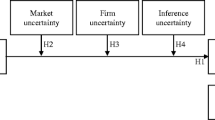Abstract
Strategic imitation occurs when one firm purposefully copies the products, processes, managerial methods, organizational form, market entry and/or investment timing of another firm with the intention of fulfilling a strategic goal. This imitation can be purposeful and take various forms, such as counterfeiting, reverse engineering or the adoption of best practices, or it can be accidental, such as when rival firms respond to the same external shock. External drivers such as globalization, the codification and commodization of knowledge, advances in technology and communication, and recent phenomena such as imitation clusters and private labelling serve to propel imitative behaviour. While motives for imitation vary for specific firms, scholars have suggested theoretically based motivations, such as the need for information, risk minimization and culturally based collectivistic behaviour.
Access this chapter
Tax calculation will be finalised at checkout
Purchases are for personal use only
Similar content being viewed by others
References
ACNielsen. 2005. The power of the private label 2005: A review of growth trends around the world. Executive News Report from ACNielsen Global Services, September.
Axelrod, R. 1984. The evolution of cooperation. New York: Basic Books.
Barreto, I., and C. Baden-Fuller. 2006. To conform or to perform? Mimetic behavior, legitimacy-based groups and performance consequences. Journal of Management Studies 43: 1559–1581.
Bikchandi, S., D. Hirschleifer, and I. Welch. 1992. A theory of fads, fashion, custom and cultural change as informational cascades. Journal of Political Economy 100: 992–1026.
CAEFI (China Association of Enterprises with Foreign Investment). 2004. Annual report. Quality Brands Protection Committee.
Campos, P., and P. Brazdil. 2005. Imitation networks and organizational survival in the Portuguese industry. Paper presented at 2005 Portuguese conference on artificial intelligence, Covilha, 5–8 Dec, 325–328.
DiMaggio, P.J., and W.W. Powell. 1983. The iron cage revisited: Institutional isomorphism and collective rationality in organizational fields. American Sociological Review 48: 147–160.
Fiegenbaum, A., and H. Thomas. 1995. Strategic groups as reference groups: Theory, modeling and empirical examination of industry and competitive strategy. Strategic Management Journal 16: 461–476.
Galaskiewicz, J., and S. Wasserman. 1989. Mimetic processes within an interorganizational field: An empirical test. Administrative Science Quarterly 34: 454–479.
Garcia-Pont, C., and N. Nohria. 2002. Local versus global mimetism: The dynamics of alliance formation in the automobile industry. Strategic Management Journal 23: 307–321.
Hawley, A.H. 1986. Human ecology: A theoretical essay. Chicago: University of Chicago Press.
Head, K., T. Mayer, and J. Ries. 2002. Revisiting oligopolistic reaction: Are decisions on foreign direct investments strategic complements? Journal of Economics and Management Strategy 11: 453–472.
Herbig, P., and J. Miller. 1992. Culture and technology: Does the traffic move in both directions? Journal of Global Marketing 6: 75–104.
Hobday, M., H. Rush, and J. Bessant. 2004. Approaching the innovation frontier in Korea: The transition phase to leadership. Research Policy 33: 1433–1457.
Kale, D., and S. Little. 2007. From imitation to innovation: The evolution of R&D capabilities and learning processes in the Indian pharmaceutical industry. Technology Analysis and Strategic Management 19: 589–609.
Katz, M.L., and C. Shapiro. 1985. Network externalities, competition, and compatibility. American Economic Review 75: 424–440.
Klemperer, P. 1992. Equilibrium product lines: Competing head-to-head may be less competitive. American Economic Review 82: 740–755.
Knickerbocker, F.T. 1973. Oligopolistic reaction and multinational enterprise. Boston: Harvard Business School Press.
Leibenstein, H. 1950. Bandwagon, snob, and Veblen effects in the theory of consumers’ demand. Quarterly Journal of Economics 64: 183–207.
Lieberman, M.B., and S. Asaba. 2006. Why do firms imitate each other? Academy of Management Review 31: 366–385.
Lieberman, M.B., and D.B. Montgomery. 1988. First-mover advantages. Strategic Management Journal 9: 41–58.
Mansfield, E., M. Schwartz, and S. Wagner. 1981. Imitation costs and patents: An empirical study. Economic Journal 91: 907–918.
Martin, X., A. Swaminathan, and W. Mitchell. 1998. Organizational evolution in the interorganizational environment: Incentives and constraints on international expansion strategy. Administrative Science Quarterly 43: 566–601.
Mathews, J.A. 2006. Catch-up strategies and the latecomer effect in industrial development. New Political Economy 11: 313–335.
Milliken, F.J. 1987. Three types of perceived uncertainty about the environment. Academy of Management Review 12: 133–143.
Minagawa, T., P. Trott, and A. Hoecht. 2007. Counterfeit, imitation, reverse engineering and learning: Reflections from Chinese manufacturing firms. R&D Management 37: 455–467.
Motta, M. 1994. International trade and investments in a vertically differentiated industry. International Journal of Industrial Organization 12: 179–196.
Parvis, E.N. 2002. The pharmaceutical industry: Access and outlook. Hauppauge: Nova.
Porter, M.E. 1979. The structure within industries and companies’ performance. Review of Economics and Statistics 61: 214–227.
Rogers, E.M. 1995. Diffusion of innovations, 4th ed. New York: Free Press.
Scherer, F.M. 1980. Industrial market structure and economic performance. Chicago: Rand McNally & Company.
Schwartz, M.A. 1978. The imitation and diffusion of industrial motivations. Ann Arbor: University of Michigan Press.
Shenkar, O. 2010. Copycats: How smart companies use imitation to gain a strategic edge. Boston: Harvard Business Press.
Yang, D. 2005. Culture matters to multinationals’ intellectual property businesses. Journal of World Business 40: 281–301.
Zander, U., and B. Kogut. 1995. Knowledge and the speed of the transfer and imitation of organizational capabilities. Organizational Science 6: 76–92.
Author information
Authors and Affiliations
Corresponding author
Editor information
Editors and Affiliations
Copyright information
© 2018 Macmillan Publishers Ltd., part of Springer Nature
About this entry
Cite this entry
Young, S.L., Barney, J.B. (2018). Strategic Imitation. In: Augier, M., Teece, D.J. (eds) The Palgrave Encyclopedia of Strategic Management. Palgrave Macmillan, London. https://doi.org/10.1057/978-1-137-00772-8_275
Download citation
DOI: https://doi.org/10.1057/978-1-137-00772-8_275
Published:
Publisher Name: Palgrave Macmillan, London
Print ISBN: 978-0-230-53721-7
Online ISBN: 978-1-137-00772-8
eBook Packages: Business and ManagementReference Module Humanities and Social SciencesReference Module Business, Economics and Social Sciences



